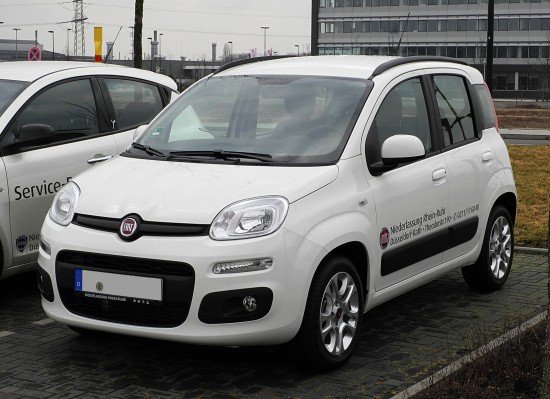Next Fiat Panda To Rival Citroen Cactus
During FCA’s most recent five year plan presentation, Fiat was the sole brand that did not have any semblance of a unified direction. While Fiat is decidedly mainstream in key markets such as Brazil and Latin America, it appears that FCA is trying to re-position the brand as something else entirely in Europe and North America. Key to this plan will be an all new, bare bones C-segment vehicle that could end up wearing the Panda badge.
According to the UK’s Autocar, Fiat’s lineup will focus on a series of CUVs in the immediate future, including the Jeep-derived 500X and a variant of the next-gen Jeep Compass. But once those are launched, the next product from Fiat will be
a back-to-basics C-segment hatchback and estate, replacing the unsuccessful Fiat Bravo. These will be based on the same platform as the 500L MPV and will be built in Turkey, where labour rates are cheaper.
Insiders have told Autocar that the new models will not be as “basic” as Dacia’s successful models, but will be “very well priced”. Some rumours suggest that Marchionne will use the well-regarded Panda badge for the Bravo replacement, neatly rebuilding the Panda family as Fiat’s no-nonsense sub-brand.
According to the article, the C-segment, which makes up nearly a third of the EU’s new car market, is plagued by profit margins that range from razor thin to non-existent. High labor costs, consumer demands for advanced feature content and market saturation have all contributed to this situation. While VW’s MQB platform allows for significant economies of scale, their rivals aren’t in the same position. On the other hand, Renault’s Dacia brand can enjoy margins of as much as 10 percent (compared to 2-3 percent on average) thanks to low labor costs, spartan levels of equipment and the use of old, already amortized technology.
The middle ground for mainstream auto makers lies in something like the Citroen Cactus. The Cactus looks chic, but has a number of innovative cost-cutting measures (like rear windows that pop out, rather than roll down) to keep costs down. Fuel efficiency is achieved through reducing weight rather than expensive, advanced technology. If the Dacia is the automotive equivalent of Wal-Mart, then the Cactus is something like H&M – frugal, but now dowdy. The fact that the Cactus uses the underpinings of a B-segment car, but is priced more like a C-segment car doesn’t hurt either.
Following this example for the Panda would be the most logical path for Fiat to take. The Panda name has a lot of brand equity, thanks to its longevity and the widespread acclaim it has garnered from both consumers and the automotive media. Not long ago, it was regarded as the best handling small car money could buy. But in the next half of this decade, the focus will have to shift on creating something that will make consumers consider a Fiat, when there are literally hundreds of other nameplates available. A Cactus competitor doesn’t seem like such a bad start.
More by Derek Kreindler
Latest Car Reviews
Read moreLatest Product Reviews
Read moreRecent Comments
- 3-On-The-Tree Besides for the sake of emissions I don’t understand why the OEM’s went with small displacement twin turbo engines in heavy trucks. Like you guys stated above there really isn’t a MPG advantage. Plus that engine is under stress pulling that truck around then you hit it with turbos, more rpm’s , air, fuel, heat. My F-150 Ecoboost 3.5 went through one turbo replacement and the other was leaking. l’ll stick with my 2021 V8 Tundra.
- Syke What I'll never understand about economics reporting: $1.1 billion net income is a mark of failure? Anyone with half a brain recognizes that Tesla is slowly settling in to becoming just another EV manufacturer, now that the legacy manufacturers have gained a sense of reality and quit tripping over their own feet in converting their product lines. Who is stupid enough to believe that Tesla is going to remain 90% of the EV market for the next ten years?Or is it just cheap headlines to highlight another Tesla "problem"?
- Rna65689660 I had an AMG G-Wagon roar past me at night doing 90 - 100. What a glorious sound. This won’t get the same vibe.
- Marc Muskrat only said what he needed to say to make the stock pop. These aren't the droids you're looking for. Move along.
- SCE to AUX I never believed they cancelled it. That idea was promoted by people who concluded that the stupid robotaxi idea was a replacement for the cheaper car; Tesla never said that.


































Comments
Join the conversation
Some time ago, Fiat said that the brand will have two different product lines. 500 on the emotional/premium side, and Panda on the more practical/'down-to-earth' side. So this actually makes sense. Th Panda will be an A-segment car as it is just now, while Fiat (probably) will also introduce a Panda L (basically the 500L in my opinion) and Panda XL. About the 124, technically it was a D-segment car. The Bravo's predecessor of that era would be the 128.
Panda brand is dying. Still awaiting 105bhp Twin-air. Europe brand-recognition only. Overall Car Lengths. 500 (1957) 2.97m; 500 (2007) 3.55m; 500L 4.14m & 4.35m (MPW); 500X 4.24m. 124 4.04m. Nice you consider the 124 as a D-segment car. At C-segment prices, it will seem like a bargain. And with the halo-effect of the 124 Spider, it will seem like a desirable bargain. Marchionne will be pleased!